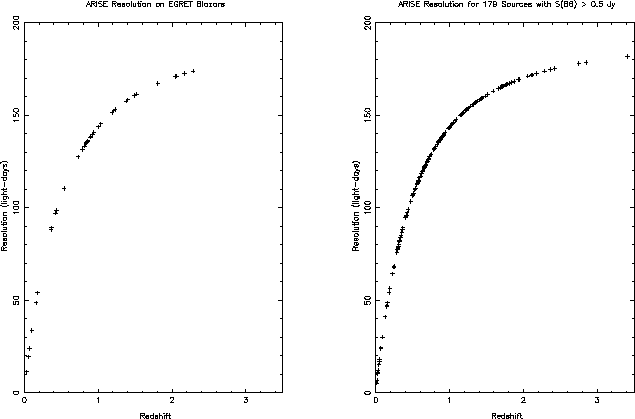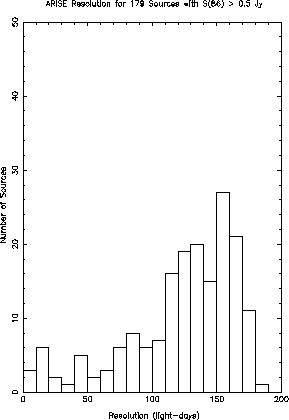Linear Resolution
Next: References Up: 86-GHz Blazar Imaging on Previous: Brightness-Temperature Threshold
Linear Resolution
The linear resolution for a 50,000-km baseline can be computed
for the class of gamma-ray blazars detected by the EGRET
instrument. If we assume ![]() km
sec
km
sec![]() Mpc
Mpc![]() and
and ![]() , then the ARISE
resolution for most of the blazars listed by Mattox et al. (1997)
will be between 100 and 200 light days; 8 of the 38 objects with
measured redshifts would have resolution better than 100 light
days. The left-hand panel of Figure 1 shows the linear resolution available
for each of these EGRET blazars.
, then the ARISE
resolution for most of the blazars listed by Mattox et al. (1997)
will be between 100 and 200 light days; 8 of the 38 objects with
measured redshifts would have resolution better than 100 light
days. The left-hand panel of Figure 1 shows the linear resolution available
for each of these EGRET blazars.

Figure 1: Redshift and linear resolution of
ARISE at 86 GHz, assuming a baseline length of 50,000 km.
Left: The 38 EGRET blazars listed by Mattox et al. (1997)
that have known redshifts. Right: The 179 compact sources,
from the OVRO calibrator list (1999) and Beasley et al. (1997),
which have ![]() Jy and measured
redshifts. Almost all these sources will be detected by
GLAST.
Jy and measured
redshifts. Almost all these sources will be detected by
GLAST.
Finally, we note that the GLAST mission will have a gamma-ray
sensitivity 30 times better than EGRET. Assuming ![]() , GLAST should detect more than 6000 active galactic
nuclei (AGNs) in gamma rays, 150 times more than seen by EGRET.
This should include all the AGNs that are strong at 86 GHz, and
many more. The right-hand panel of Figure 1 shows the linear resolution available
for the 179 sources from Beasley et al. (1997) and the OVRO
calibrator list (1999) that have 86-GHz flux densities of 0.5 Jy
or greater and measured redshifts.
, GLAST should detect more than 6000 active galactic
nuclei (AGNs) in gamma rays, 150 times more than seen by EGRET.
This should include all the AGNs that are strong at 86 GHz, and
many more. The right-hand panel of Figure 1 shows the linear resolution available
for the 179 sources from Beasley et al. (1997) and the OVRO
calibrator list (1999) that have 86-GHz flux densities of 0.5 Jy
or greater and measured redshifts.![]() Figure 2 is a histogram of the
available resolution, in intervals of 10 light days. This figure
shows that about 41 of the 179 sources can be observed with a
resolution better than 100 light days on a 50,000-km baseline,
with 16 sources having resolution better than 50 light days, and
about 10 better than 20 light days. If we correct for
incompleteness in these catalogs and the associated estimates,
all the numbers of sources should be increased by at least 50%,
to about 60 detectable objects with resolution better than 100
light days and 15 such objects with resolution better than 20
light days.
Figure 2 is a histogram of the
available resolution, in intervals of 10 light days. This figure
shows that about 41 of the 179 sources can be observed with a
resolution better than 100 light days on a 50,000-km baseline,
with 16 sources having resolution better than 50 light days, and
about 10 better than 20 light days. If we correct for
incompleteness in these catalogs and the associated estimates,
all the numbers of sources should be increased by at least 50%,
to about 60 detectable objects with resolution better than 100
light days and 15 such objects with resolution better than 20
light days.

Figure 2: Histogram of linear resolution
available for ARISE at 86 GHz, assuming a baseline length of
50,000 km. The (incomplete) source sample includes the 179
compact sources from the OVRO calibrator list (1999) and Beasley
et al. (1997) which have ![]() Jy and
measured redshifts.
Jy and
measured redshifts.
Acknowledgments
I thank David Murphy for useful comments on an earlier draft of this report, and Tony Beasley for making me aware of the SEST high-frequency survey.
Next: References Up: 86-GHz Blazar Imaging on Previous: Brightness-Temperature Threshold




Connect with NRAO